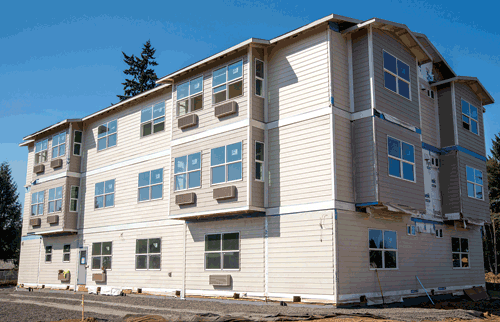When the CEO of Oregon-based Elite Care decided to expand into Clark County, he had big goals and a tight timeline.
Jason Hess wanted the residential care community to meet LEED Platinum environmental standards, and he also wanted to finish construction in just five months. But with traditional construction techniques, he estimated it could take a full year or more to build the 48 apartment suites he envisioned at 2400 N.E. 112th Avenue in Vancouver.
So Hess opted for a non-traditional option that has been growing in popularity: modular construction.
Long associated with low-income manufactured home parks, modular building techniques have come a long way in recent years. No longer just a cheap alternative to traditional methods, modular buildings can meet high-quality standards like those set by the U.S. Green Building Council. These techniques, which draw on lean manufacturing principles, can also allow commercial enterprises to get up and running faster than stick-built construction. As the benefits of modular construction grow and the industry overcomes its historical disadvantages, companies are taking note.
“We expect to see continued growth for our commercial building providers as the modular construction industry continues to adopt innovative and efficient construction techniques,” Tom Hardiman, executive director of the Modular Building Institute, said in a recent statement. According to a forecast by consulting group FMI Corp., modular construction is likely to grow faster than traditional construction techniques in the years ahead.
The quick pace of construction is behind many businesses’ decision to go with modular construction, said Derek Burns, territory manager for Modspace and an active member of the Southwest Washington Contractors Association. By avoiding the delays associated with traditional construction or remodeling, companies see a much quicker return on their investments, he said.
Start to finish, Elite Care’s Vancouver project should take about five months to build, said Justin Adams, an Elite Care spokesman. “It cuts the construction time in half.”
“Another issue that sways many customers to go the modular route is the limited site disruption that modular projects typically involve,” Modspace’s Burns wrote in an email. “This was the deciding factor for a client that I developed two two-story buildings for in Hillsboro last year. As a busy 46-acre wholesale nursery, this particular customer simply could not afford to have their only shipping entrance obstructed for six to nine months for a traditional site-built project. Instead, they self-performed the site work while the buildings were constructed in plant, and delivery and installation was completed in a matter of weeks. All totaled, their gate was out of service for less than two hours.”
Proponents of modular construction tout its efficiency and environmental benefits. Although traditional building methods have improved productivity over recent decades, a 2007 study estimated that projects still create waste amounting to 25 percent to 50 percent of materials. Large stick-built projects typically involve multiple subcontracting businesses, which make it hard to apply lean manufacturing methods and environmental principles during construction. Off-site modular manufacturing makes it easier to reduce waste and make construction more efficient, as the National Research Council found in its recent “Advancing the Competitiveness and Efficiency of the U.S. Construction Industry” report.
Speed and high-quality environmental construction both come at a price, of course. While some modular buildings cost less than traditional ones, others can cost more than traditional construction.
It’s not yet clear if Elite Care’s Vancouver site will cost less because of its modular construction, Adams said. The company’s desire to open for business as soon as possible was a bigger driving force than potential savings.
Businesses should also be aware that permits can be tricky to obtain when regulators aren’t familiar with modular building techniques.
“There are more hoops to jump through,” Adams said. Elite Care had to go through extra steps with state Health and Labor & Industries agencies to prove that its structures, which will house seniors with dementia and other cognitive challenges, will comply with state rules and regulations.
Weather and distance can also factor into the equation. According to trade publication Modular Today, transporting buildings more than 500 miles can add weather-related wear-and-tear that may degrade the original construction quality. Significantly tall or wide buildings must be pieced together from components small enough to traverse highways and pass under bridges – though a planned 32-story New York City condo building proves that this obstacle can be overcome.
In Elite Care’s case, a Klamath Falls, Oregon, company built components in Southern Oregon, and then trucked the “pods” to Vancouver to be snapped together like Lego blocks.
“They’re assembled to near completion,” with carpets, plumbing and wiring in place, Adams said. Then, after acclimatizing for two days in Vancouver, a large crane lifts components into place. “Once they are stacked, a new team comes in and basically stitches up all the seams.”
Elite Care’s experience in Vancouver has convinced the company to stick with modular construction as it expands on its current Milwaukie, Oregon, campus and eyes continued growth in the metro area and beyond.



